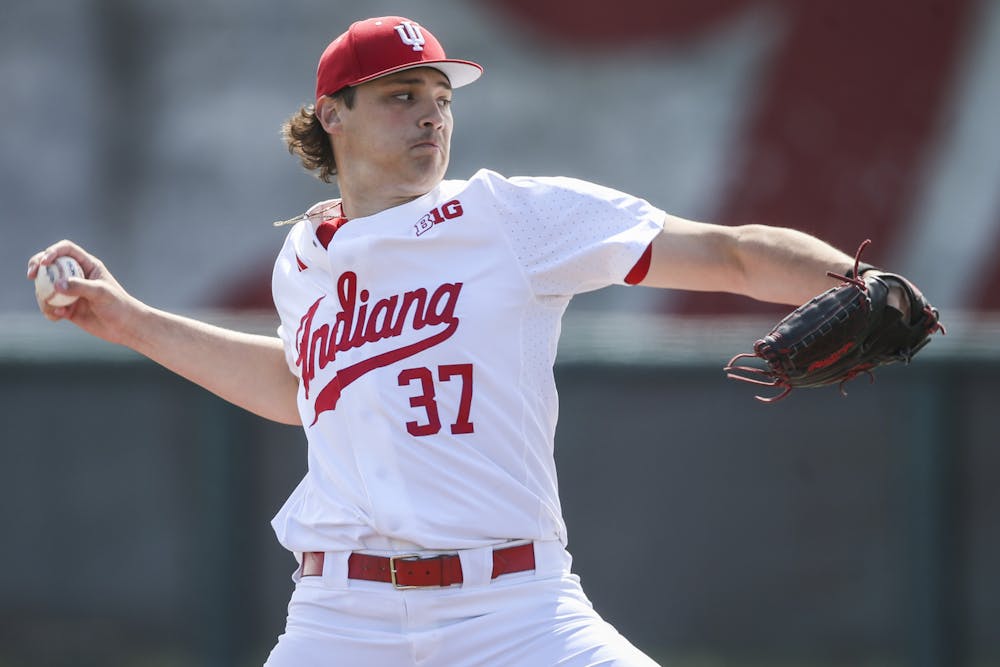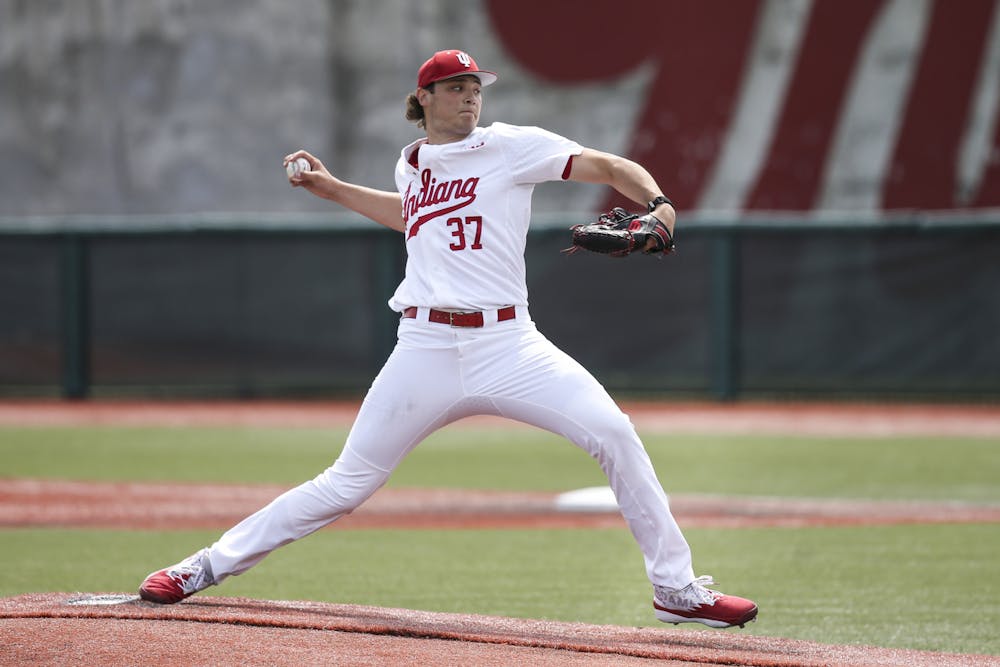In Luke Sinnard’s own words, he pitches pissed off.
Once a weekend, he lights a fire on the heels of his own size 15 cleats with the intention of extinguishing the opposing lineup. His 6-foot-8 frame becomes an even more menacing 7-foot-6 when he toes the rubber atop the 10-inch elevated mound. His mindset is even bigger than the imposing silhouette he pitches with.
He’s only a sophomore in college — not yet old enough to buy an alcoholic beverage. But go ahead, pit him against any batter. He’s trained himself to only understand one outcome.
“I think one day, I stepped on the mound and thought to myself, ‘There’s no way you can get a hit off me, I’m 10 times better than you,’” Sinnard said. “No matter who’s at the plate — it could be Mike Trout up there — I’m thinking to myself, ‘I’m going to get this ball where I want it to. I’m going to execute this pitch, you’re not going to hit it. I’m just better.”
From head coach Jeff Mercer’s young, player-led group, Sinnard has emerged as Indiana’s weekend workhorse, a bonafide starter with the desire to take the ball at every opportunity. Yet, coming off a season of struggles at Western Kentucky before his arrival to Indiana, Sinnard was a long way away from his weekly self-assertions that the Hoosiers have become accustomed to.
Pitching coach Dustin Glant had an inkling that he had something special on his hands with Sinnard. With a little help, perhaps Indiana could extract what’s always been inside of him. So, midway through the fall of 2022, Sinnard was called into Glant’s office for a conversation that many around the program knew the young up-and-comer needed.
Everyone, except for him.

“You just don’t run across that very much.”
Luke Sinnard wants to play baseball at the next level. He was never going to last in any other sport.
“I wasn’t the starting quarterback,” Sinnard said of his football career. “I was in there in the late-game situations to throw Hail Mary passes to hopefully score.”
Instead, his massive right arm yielded the type of potential that drew college baseball coaches’ attention. His throwing hand surely meant he could spin a football well, but he completely engulfs the 3-inch diameter of a baseball. Sinnard says he was always surrounded by other big arms, such as Tennessee’s Chase Burns — Burns was a consensus All-American and National Pitcher of the Year his first season in Knoxville — and that meant that Sinnard was never really the top guy, never getting the most attention.
“I honestly didn’t sprout until my junior summer, that’s when I really focused on baseball,” Sinnard said. “I was kind of late into my recruiting process, and junior year was also my COVID year, so that kinda stalled too.”
Ultimately, Sinnard opted for Western Kentucky over Georgia State and junior college powerhouse Walters State. With the Hilltoppers, Sinnard would not only be closer to home but be at the Division I level right out of high school. It was a logical decision for someone who desires to play beyond his college years.
However, an admittedly timid Sinnard struggled to find his footing until the beginning of conference play. He made 11 appearances for the Hilltoppers, and his last outing was his best one — six innings, four hits, just one earned run and five strikeouts at Bellarmine on May 17, 2022.
When the coaching staff left at the season’s end, Sinnard felt it was the time for him to do the same. His numbers across the board weren’t representative of his potential. Sinnard wanted a fresh start and an environment where everyone had a common goal.
Enter: Indiana.
Sinnard didn’t want a parallel move — he sought to either refine himself at the JUCO level or go up to a high-major. His final choices reflected his desires: San Jacinto College, a storied and successful JUCO program in Texas, and Indiana.
When surfing portal options, a database put together by Glant, assistant coach Derek Simmons and Indiana’s managers ranked every single pitcher in the portal by a certain set of criteria they found important: free base numbers (from walks, hit-by-pitches, etc.), strikeout numbers, how often opponents swing and miss at a guy’s stuff, pitch spin profiles and other advanced metrics. So when Sinnard’s frame and profile emerged near the top of their created algorithm, there was immediate intrigue.
Acting quickly, Glant went to watch him pitch.
“To have a guy that big and move that well mechanically, he’s really sound. It’s just rare,” Glant said, recalling his first impressions. “Usually guys that big are super stiff or they have kind of a unique arm action or something, and for him to be six-eight and clean, athletic — you just don’t run across that very much.”

“It got me excited again.”
Dustin Glant has seen a thing or two.
Now in his second year in Bloomington after stints in the professional ranks as both a player and coach, Glant was drafted out of Purdue in the seventh round of the 2003 MLB Draft to the Arizona Diamondbacks. Glant left the Boilermaker program fourth in all-time career saves, and spent six years within the Diamondbacks’ organization, where he climbed as high as Triple A. He then spent another three years pitching in independent ball. Since 2013, his transition to coaching has been a smooth one.
Glant has the pedigree and the experience at the levels Sinnard aspires to reach. Box checked.
“He came and saw me at a summer ball game in my hometown,” Sinnard said.
Glant must’ve liked what he saw Hendersonville, Tennessee, that day. In the two games before Sinnard made his eventual commitment to Indiana, he was a part of two wins on the mound for Full Count Rhythm — five innings of no-hit, seven-strikeout ball versus the Franklin Duelers on June 3 and six innings of one-run pitching with seven more strikeouts June 10 versus the Hoptown Hoppers. Sinnard was credited with the win in both outings.
After an initial conversation with Glant and a visit to campus, he was sold.
Glant’s pitch was simple – he showed Sinnard the areas he could improve his game with just a limited amount of film, and the two formed a plan of how they could do so. Sinnard’s new regimen would be reminiscent of the plan that helped him sprout in the first place.
“I didn’t feel like I had that at Western, and Glant brought that back,” Sinnard said. “It got me excited again.”
Another one of the targets Indiana recruited out of the portal was his Hilltopper teammate Cooper Hellman. Six days prior to Sinnard’s decision to come to Indiana, Hellman announced his intentions to do so.
Now, Bloomington had a sense of familiarity. He wouldn’t be alone, and he knew the end goal was the same for everyone. His decision became clearer.
“Once he told me he transferred here, I was kinda like that,” Sinnard said as he snapped his fingers.

“I don’t know if you know this or not, but you’re incredible.”
Jeff Mercer had a completely different version of Luke Sinnard when he first arrived on campus.
The creation of a new one started in the weight room.
“He has completely transformed his body,” Mercer said. “He’s completely overhauled himself.”
In the fall, Sinnard says he came in around 265 pounds with 27 or 28 percent body fat, although he can’t remember exactly. Mercer’s report shows 15 pounds of fat lost and 20 pounds of muscle gained, and Sinnard says that he finished the fall at about 250 pounds and 18 percent body fat. Not only has it made him more athletic, but it’s built his confidence too.
“Luke didn’t know he was good,” Mercer said. “I think that’s the most incredible thing.”
So, Mercer and Glant figured it was time to let him know.
Conversations like this one are why Sinnard wanted to be here at Indiana. Not because he wanted to hear someone puff him up, but because he wanted his work ethic and improvement to warrant this conversation. A humble giant, his modest, soft-spoken nature makes talking about himself in any self-serving light uncomfortable.
It has always been his mindset, just not vocally. Because of the rapport he and Glant built throughout his recruitment, Sinnard had earned the right to hear it from who he needed to hear it from and when he needed it most.
“I don’t know if you know this or not, but you’re incredible,” Glant told him in that meeting.
Lying to a guy early and making him think he’s got it all figured out does him no good. Mercer says kids can see through that. That’s not his job. Instead, a good coach focuses on creating a development pattern and plan to help players deal with the inevitable bumps in the road.
Mercer would rather be up front and forward with his feedback. So, when it came time to infuse some confidence into his sophomore starter, the stern, straight-forward attitude that Glant boasts was the rational choice.
“He hadn’t had a lot of success, but the potential was there,” Glant said. “And so, it was just letting him know that, ‘Hey man, don’t base your confidence on (last season). I get it, maybe you weren’t as good, you didn’t perform as well as you wanted to last year. But I’ve been doing this a while, man. You’ve got a lot of key ingredients here. You’ve got a chance and we believe in you. You need to believe in yourself.’”
Mercer knows Glant is brutally honest — sometimes to a fault. Sugarcoating isn’t Glant’s business; you’ll know what he’s thinking because he’ll tell you himself. There is no guesswork involved with the way he operates, and his opinions carry weight around the Indiana locker room and coaching staff.
When he tells you you’re special, Mercer says, you better believe him.
“I think that breathes life into you with a little confidence and belief,” Mercer said. “You make a few adjustments and it’s like, ‘No, you’re right. I am really good.’”
At Indiana, Sinnard’s pitch repertoire has been completely revolutionized. With Western, he threw just a fastball and a curveball, plus a slider he developed himself late in the season. With Glant’s help, he’s added a cutter and a splitter — a pitch that Glant says making a wipeout pitch will be the next step in his progression.
They’ve changed his arm slot to emphasize the run on his fastball with greater impact and switched his pitch usage rates to fool hitters more often. Now, the same metrics that originally spurned Indiana’s interest in Sinnard suggest that his curveball is among the best in the country.
“Once he kind of got it going, it was like a bowling ball, butcher knife, downhill right now,” Mercer said. “Now, he’s an unstoppable force for us.”
Indiana’s staff relies on him as he’s relied on them. Together, the partnership has formed a winning harmony.
“That boy is built different.”
As a starting pitcher, Sinnard is routine-oriented. His favorite part of the week is getting between the lines and pitching against an opponent, something Glant says is Sinnard’s best attribute.
“He’d go out there every day for you if he could,” Glant said. “He’s just super competitive.”
He also hates hitters. Can’t stand them. It became apparent to Mercer and Glant in the fall that Sinnard’s approach to his craft is unique.
But, what do pitchers who hate hitters look like?
Do they love the moment and love competing?
Do they carry a grudge and pitch with an attitude?
Answer yes to these questions and you get Luke Sinnard.
“It was pretty early on in the fall that we thought, ‘Man oh man, we think we got one here,’” Mercer said.
Sinnard’s trip to Glant’s office kickstarted him. Sinnard now wanted to outwork his teammates at every turn, to spend every moment possible in the weight room. All of a sudden, any time not spent on perfecting his craft was time wasted.
He carries himself as a dominant force. On the mound he’s constantly on the attack, always being aggressive. Mercer calls him a freight train. Sinnard’s favorite pitcher is Gerrit Cole, the Yankees ace who exemplifies the same overpowering approach to attacking hitters.
So, when he’s cruising through the first seven batters of a Morehead State lineup — all of which retired via a strikeout — before a walk and two-run home run gets the Golden Eagles on the board, he’s unfazed.
“You see guys all the time, a guy homers — ‘Oh poor pity me, I can’t believe you did that,’” Mercer said following the mid-March outing. “And then it’s like walk, four-pitch walk, then he hits the next guy in the back — it’s like, ‘For crying out loud man, you’re fine. Just finish the inning and we’ll move on.’”
And he did. Two quick outs ended the frame en route to six complete innings of work and 13 strikeouts that night.
“That’s what he does,” Mercer continued. “That boy is built different.”






